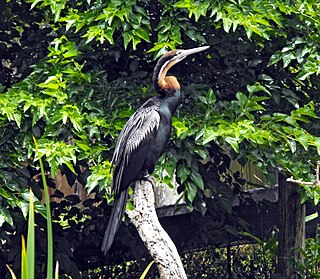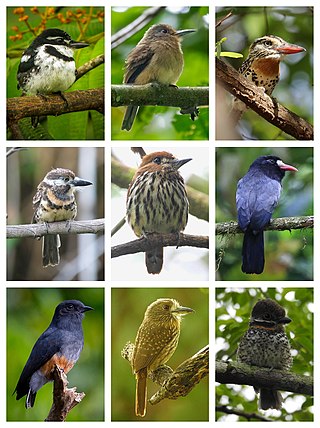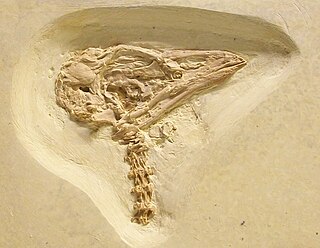
Gaviiformes is an order of aquatic birds containing the loons or divers and their closest extinct relatives. Modern gaviiformes are found in many parts of North America and northern Eurasia, though prehistoric species were more widespread.

The darters, anhingas, or snakebirds are mainly tropical waterbirds in the family Anhingidae, which contains a single genus, Anhinga. There are four living species, three of which are very common and widespread while the fourth is rarer and classified as near-threatened by the IUCN. The term snakebird is usually used without any additions to signify whichever of the completely allopatric species occurs in any one region. It refers to their long thin neck, which has a snake-like appearance when they swim with their bodies submerged, or when mated pairs twist it during their bonding displays. "Darter" is used with a geographical term when referring to particular species. It alludes to their manner of procuring food, as they impale fishes with their thin, pointed beak. The American darter is more commonly known as the anhinga. It is sometimes called "water turkey" in the southern United States; though the anhinga is quite unrelated to the wild turkey, they are both large, blackish birds with long tails that are sometimes hunted for food.

The Coraciiformes are a group of usually colourful birds including the kingfishers, the bee-eaters, the rollers, the motmots, and the todies. They generally have syndactyly, with three forward-pointing toes, though in many kingfishers one of these is missing. The members of this order are linked by their "slamming" behaviour, thrashing their prey onto surfaces to disarm or incapacitate them.

The mousebirds are birds in the order Coliiformes. They are the sister group to the clade Cavitaves, which includes the Leptosomiformes, Trogoniformes (trogons), Bucerotiformes, Piciformes and Coraciformes. This group is now confined to sub-Saharan Africa, and it is the only bird order confined entirely to that continent, with the possible exception of turacos which are considered by some as the distinct order Musophagiformes, and the cuckoo roller, which is the only member of the order Leptosomiformes, and which is found in Madagascar but not mainland Africa. Mousebirds had a wider range in the Paleogene, with a widespread distribution in Europe and North America during the Paleocene.

The puffbirds and their relatives in the family Bucconidae are tropical tree-dwelling insectivorous birds that are found from South America up to Mexico. Together with their closest relatives, the jacamars, they form a divergent lineage within the order Piciformes, though the two families are sometimes elevated to a separate order Galbuliformes. Lacking the iridescent colours of the jacamars, puffbirds are mainly brown, rufous or grey, with large heads, large eyes, and flattened bills with a hooked tip. Their loose, abundant plumage and short tails makes them look stout and puffy, giving rise to the English name of the family. The species range in size from the rufous-capped nunlet, at 13 cm (5.1 in) and 14 g (0.49 oz), to the white-necked puffbird, at up to 29 cm (11 in) and 106 g (3.7 oz).

Gastornis is an extinct genus of large, flightless birds that lived during the mid-Paleocene to mid-Eocene epochs of the Paleogene period. Most fossils have been found in Europe, and possible specimens are known in North America and Asia. Several genera including Diatryma were historically considered to be congeneric with Gastornis, but recent interpretations challenged this referral.

Fossil Butte National Monument is a United States National Monument managed by the National Park Service, located 15 miles (24 km) west of Kemmerer, Wyoming, United States. It centers on an assemblage of Eocene Epoch animal and plant fossils associated with Fossil Lake—the smallest lake of the three great lakes which were then present in what are now Wyoming, Utah, and Colorado. The other two lakes were Lake Gosiute and Lake Uinta. Fossil Butte National Monument was established as a national monument on October 23, 1972.

Elopteryx is a genus of paravian theropod dinosaur based on fragmentary fossils found in Late Cretaceous rocks of Romania. The single species, Elopteryx nopcsai, was known only from very incomplete material until new specimens were reported in the 21st century. Balaur bondoc might represent a junior synonym of this taxon.
Storrs Lovejoy Olson was an American biologist and ornithologist who spent his career at the Smithsonian Institution, retiring in 2008. One of the world's foremost avian paleontologists, he was best known for his studies of fossil and subfossil birds on islands such as Ascension, St. Helena and Hawaii. His early higher education took place at Florida State University in 1966, where he obtained a B.A. in biology, and the University of Florida, where he received an M.S. in biology. Olson's doctoral studies took place at Johns Hopkins University, in what was then the School of Hygiene and Public Health. He was married to fellow paleornithologist Helen F. James.
Paleontology or palaeontology is the study of prehistoric life forms on Earth through the examination of plant and animal fossils. This includes the study of body fossils, tracks (ichnites), burrows, cast-off parts, fossilised feces (coprolites), palynomorphs and chemical residues. Because humans have encountered fossils for millennia, paleontology has a long history both before and after becoming formalized as a science. This article records significant discoveries and events related to paleontology that occurred or were published in the year 1992.
Paleontology or palaeontology is the study of prehistoric life forms on Earth through the examination of plant and animal fossils. This includes the study of body fossils, tracks (ichnites), burrows, cast-off parts, fossilised feces (coprolites), palynomorphs and chemical residues. Because humans have encountered fossils for millennia, paleontology has a long history both before and after becoming formalized as a science. This article records significant discoveries and events related to paleontology that occurred or were published in the year 1970.

Odontopteryx is a genus of the extinct pseudotooth birds or pelagornithids. These were probably rather close relatives of either pelicans and storks, or of waterfowl, and are here placed in the order Odontopterygiformes to account for this uncertainty.
Cyphornis is a genus of the prehistoric pseudotooth birds. These were probably rather close relatives of either pelicans and storks, or of waterfowl, and are here placed in the order Odontopterygiformes to account for this uncertainty.

Dasornis is a genus of prehistoric pseudotooth birds. These were probably close relatives of either pelicans and storks or waterfowl; they are placed in the order Odontopterygiformes to account for this uncertainty.
Pseudodontornis is a rather disputed genus of the prehistoric pseudotooth birds. The pseudotooth birds or pelagornithids were probably rather close relatives of either pelicans and storks, or of waterfowl, and are here placed in the order Odontopterygiformes to account for this uncertainty. Up to five species are commonly recognized in this genus.
Tympanonesiotes is a somewhat doubtfully valid genus of the prehistoric pseudotooth birds. These were probably rather close relatives of either pelicans and storks, or of waterfowl, and are here placed in the order Odontopterygiformes to account for this uncertainty.
Eostrix is a genus of extinct primitive owls in the family Protostrigidae, along with Oligostrix and Minerva. These owls date from the early Eocene of the United States, Europe, and Mongolia. They have been described based on fossil remains. The genus was created by Pierce Brodkorb in 1971 to place a fossil species known until that time as Protostrix mimica.
Palaeophasianus is an extinct genus of flightless Geranoididae birds that lived in North America during the Eocene period. Robert Wilson Shufeldt classified Palaeophasianus as a galliform when he described it in 1913. However it was transferred to Cracidae in 1964 by Pierce Brodkorb, while Joel Cracraft in 1968 placed it in Gruiformes.

Cyrilavis is an extinct genus of halcyornithid bird from the Early Eocene Fossil Butte Member of the Green River Formation, United States. The genus contains two species, Cyrilavis olsoni and Cyrilavis colburnorum.



















